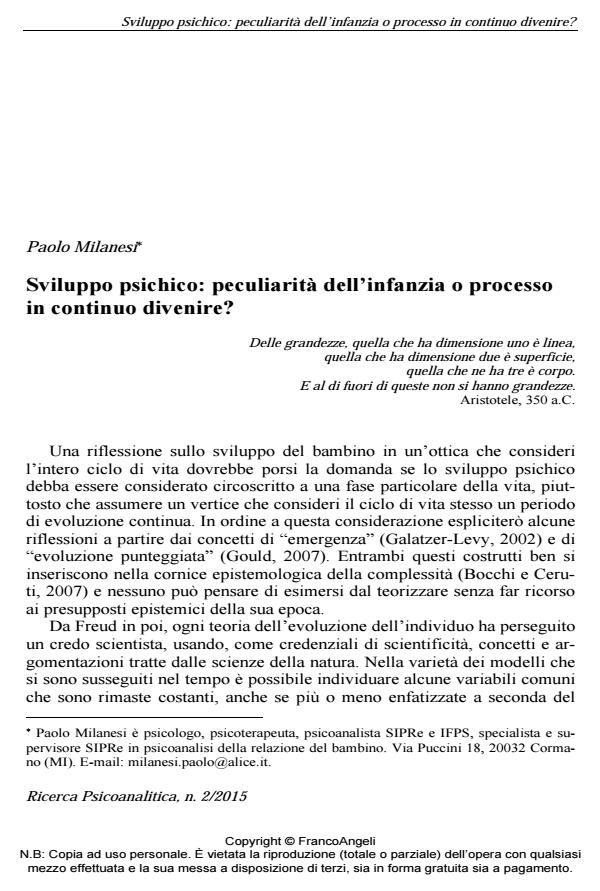Sviluppo psichico: peculiarità dell’infanzia o processo in continuo divenire?
Titolo Rivista RICERCA PSICOANALITICA
Autori/Curatori Paolo Milanesi
Anno di pubblicazione 2015 Fascicolo 2015/2
Lingua Italiano Numero pagine 30 P. 63-92 Dimensione file 439 KB
DOI 10.3280/RPR2015-002005
Il DOI è il codice a barre della proprietà intellettuale: per saperne di più
clicca qui
Qui sotto puoi vedere in anteprima la prima pagina di questo articolo.
Se questo articolo ti interessa, lo puoi acquistare (e scaricare in formato pdf) seguendo le facili indicazioni per acquistare il download credit. Acquista Download Credits per scaricare questo Articolo in formato PDF

FrancoAngeli è membro della Publishers International Linking Association, Inc (PILA)associazione indipendente e non profit per facilitare (attraverso i servizi tecnologici implementati da CrossRef.org) l’accesso degli studiosi ai contenuti digitali nelle pubblicazioni professionali e scientifiche
L’Autore ripercorre sinteticamente la storia del pensiero psicoanalitico sullo sviluppo psicologico, evidenziando alcuni presupposti epistemici alla base di esso. Viene poi introdotto il concetto di "emergenza" quale costrutto interno alle teorie dei sistemi complessi dinamici e non lineari e successivamente il punto di vista del pensiero evoluzionistico post darwiniano con particolare riferimento alla teoria degli equilibri punteggiati di Gould ed Elderidge. Ne emerge un’originale sintesi attraverso cui poter guardare allo sviluppo psicologico, non solo del bambino ma del singolo soggetto lungo l’intero arco di vita.
Parole chiave:Sviluppo psicologico; emergenza; evoluzione punteggiata; ciclo di vita; sistemi complessi dinamici non lineari; dinamiche lineari
- Le sedute congiunte genitore/bambino. Tra azione e simbolo ovvero come lavorare con gli impliciti nel contesto di vita del piccolo paziente Paolo Milanesi, Alessandro Cavelzani, in RICERCA PSICOANALITICA 2/2017 pp.23
DOI: 10.3280/RPR2017-002003 - Alle cose stesse. Un contributo del pensiero di Martin Heidegger alla meta-teoria dell’Io-soggetto Paolo Milanesi, in Ricerca Psicoanalitica /2022
DOI: 10.4081/rp.2022.540
Paolo Milanesi, Sviluppo psichico: peculiarità dell’infanzia o processo in continuo divenire? in "RICERCA PSICOANALITICA" 2/2015, pp 63-92, DOI: 10.3280/RPR2015-002005